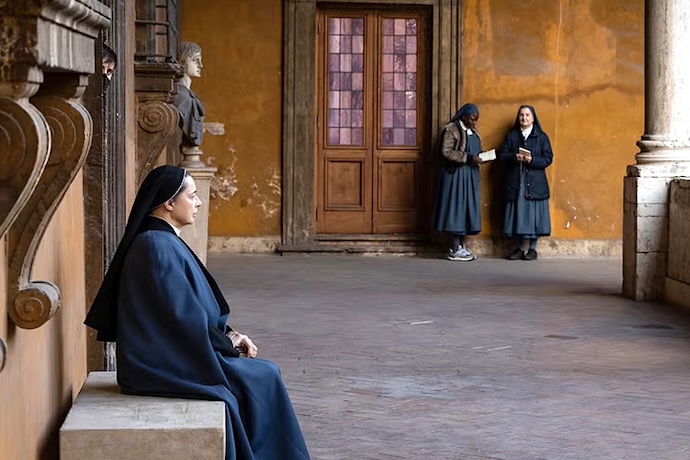There are many pleasures for students of the Catholic Church in Conclave—which recently received eight Oscar nominations—from the glimpses behind the doors of the uber-secretive papal conclave itself to the spot-on portrayal of the lush-austere pageantry of an institution that is some eight centuries older than the British monarchy. But none is more resonant than the portrait it paints of the silent, submissive nuns of the Vatican, a subtle indictment of how the church views women that adds weight to the movie’s surprise ending.
The nuns of Conclave are depicted as the worker bees of the Vatican. They labor over steaming pots of sauce and roll hundreds of delicate tortellini for the cardinals’ dinner. They set the tables, which they then clear after the feast; they make beds and attend to housekeeping. In their blue and black habits with white smocks and aprons, they even resemble servants. They’re almost always in the background, heads bowed and hands clasped, neatly lined up, or walking two by two.
The cardinals, on the other hand are, well, cardinals—bright male birds flying above it all in their red-feathered glory. Not for them the making of meals or beds. They glide through their feathered nest being dressed resplendently—burgundy velvet cloaks, scarlet cassocks and mozzetta—coddled and fed while the women work. In a particularly striking scene, they’re shown from overhead, a mass of zucchetto crossing a plaza, but they don’t walk in orderly lines; each moves in his own path, heedless of the others, like so many red atoms jostling for space.
It is the men, of course, who are at the center of the story, sequestered to choose a new pope and engaged in politically charged discussions about the future of the church. The women clear things away in the background as the men lower their voices so as not to be heard by the help.
That the subordinate role of women remains the Catholic Church’s third rail becomes evident when Stanley Tucci’s character Cardinal Aldo Bellini, the liberal American candidate for the papacy, outlines his platform. He tells the cardinals managing his bid that he wants to take a “common sense” approach to gay marriage and contraception—no more days of women having 10 children because they don’t know any better, he avers—and gets no push-back. But when he continues that he wants to increase the role of women in the curia—the body that runs the Holy See—his advisors are aghast. “Let’s not mention women,” one counsels.
It’s only when an outsider arrives at the Vatican—Cardinal Vincent Benitez, a Mexican priest who was secretly made the archbishop of Kabul by the late pope—that women are finally mentioned. After his introduction to a shocked conclave at dinner, Benitez proceeds with a blessing that expresses gratitude to the nuns for their work in preparing the meal, leaving his fellow cardinals bewildered.
Of course, women don’t remain silent throughout the movie—in fact, two women change the course of fictional papal history when they speak up. It’s the very silence that these women embody that makes their voices powerful when they do use them. You can tell that Isabella Rossellini’s Sister Agnes (for which she received an Oscar nomination) is a woman accustomed to holding her tongue—at least around male clerics. “We are supposed to be invisible,” she tells the cardinals—or, perhaps, to reassure herself that she’s largely followed the expectations of her gender—before she steps forward from the background and reveals information that destroys one of the candidates’ chances. “God has nevertheless given us eyes and ears,” she says, reminding them that women’s silence is conditional.
It’s the Vatican’s expressed preference for silent nuns that was at the heart of much of the controversy over the American religious orders that has rent the church throughout much of the late twentieth and early twenty-first centuries, as the Vatican sought to investigate U.S. nuns for speaking out in defiance of the male hierarchy and failing to model submission to papal authority. The Vatican has a long history of disciplining nuns who assert the right to speak in their own voices, especially when they counter official church positions on issues like abortion and contraception. (In the end, the investigation largely fizzled under the weight of bad publicity, with the final report calling for “a more incisive female presence in the Church.”)
In that light, the big reveal at the end of the movie by Cardinal Benitez—now Pope Innocent—suggests that the way forward is for the church to find a way to better incorporate that female presence and ultimately to recognize that, for the church itself to truly flourish, women must be included in its leadership.


